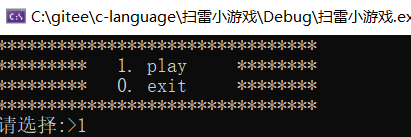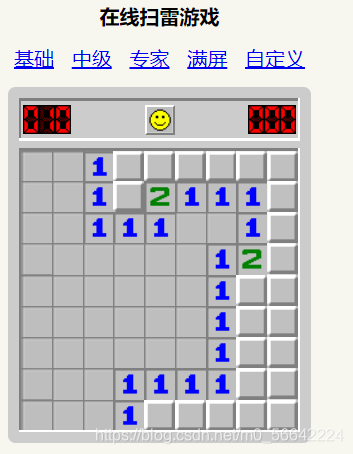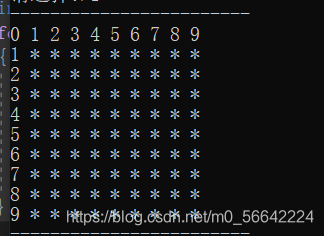利用最简单的c语言原理实现扫雷小游戏
1.实现一个简单的菜单
想必大家一定对扫雷不陌生吧,在这里我就不给大家多去介绍这个游戏的规则了,今天我们利用一些简单的c语言函数和语法去完成一个简易化的扫雷小游戏
首先将我们的主函数写出来
int main()
{
int input = 0;
srand((unsigned int)time(NULL));
do
{
menu();
printf("请选择:>");
scanf("%d", &input);
switch (input)
{
case 1:
game();
break;
case 0:
printf("退出游戏\n");
break;
default:
printf("选择错误,重新选择!\n");
break;
}
} while (input);
return 0;
}
然后将我们写的menu()函数完善
void menu()
{
printf("********************************\n");
printf("********* 1. play ********\n");
printf("********* 0. exit ********\n");
printf("********************************\n");
}
这样一个简单便利的菜单就完成了。

2.利用二维数组初始化简易的棋盘

以我们目前的技术水平虽然写不出这样子优化过的棋盘,但是我们可以以上面棋盘为模板将他转换成我们知识水平以内的一个简易的扫雷棋盘

直接贴代码:
//初始化一下棋盘
InitBoard(mine, ROWS, COLS, '0');//'0'
InitBoard(show, ROWS, COLS, '*');//'*'
#define ROW 9
#define COL 9
#define ROWS ROW+2
#define COLS COL+2
//初始化棋盘
void InitBoard(char board[ROWS][COLS], int rows, int cols, char set);
//显示棋盘
void DisplayBoard(char board[ROWS][COLS], int row, int col);
void InitBoard(char board[ROWS][COLS], int rows, int cols, char set)
{
int i = 0;
for (i = 0; i < rows; i++)
{
int j = 0;
for (j = 0; j < cols; j++)
{
board[i][j] = set;
}
}
}
利用循环和二维数组就可以把这个简单的棋盘打印出来

3.把雷随机的放入棋盘中
棋盘完成之后我们就要开始放雷了,我们要将雷随机的在我们的棋盘中放入
首先要先完成随机性,在上篇三子棋小游戏的时候我就已经讲过时间戳的概念的了这里就不赘述了直接上代码:
srand((unsigned int)time(NULL));
之后便要开始布置雷
//布置雷
SetMine(mine, ROW, COL);
DisplayBoard(show, ROW, COL);
//布置雷
void SetMine(char board[ROWS][COLS], int row, int col);
void SetMine(char board[ROWS][COLS], int row, int col)
{
int count = EASY_COUNT;
while (count)
{
//1. 生成随机下标
int x = rand() % row + 1;
int y = rand() % col + 1;
if (board[x][y] != '1')
{
board[x][y] = '1';
count--;
}
}
}
4.玩家进行排雷操作
在玩家进行排雷操作这个区域,我们主要是要解决两个问题
第一:玩家下的坐标是否是雷区
第二:坐标旁边有几个雷然后提示玩家
接下来我们就一个一个来解决这些问题吧:
//排查雷
FindMine(mine, show, ROW, COL);
//排查雷的
void FindMine(char mine[ROWS][COLS], char show[ROWS][COLS], int row, int col);
在每一次的下棋过程中提示玩家附近的雷的数量:
int GetMineCount(char mine[ROWS][COLS], int x, int y)
{
return (mine[x - 1][y] +
mine[x - 1][y - 1] +
mine[x][y - 1] +
mine[x + 1][y - 1] +
mine[x + 1][y] +
mine[x + 1][y + 1] +
mine[x][y + 1] +
mine[x - 1][y + 1] - 8 * '0');
}
void FindMine(char mine[ROWS][COLS], char show[ROWS][COLS], int row, int col)
{
int x = 0;
int y = 0;
int win = 0;
while (win < row * col - EASY_COUNT)
{
printf("请输入要排查的坐标:>");
scanf("%d %d", &x, &y);
if (x >= 1 && x <= row && y >= 1 && y <= col)
{
if (mine[x][y] == '1')
{
printf("很遗憾,你被炸死了\n");
DisplayBoard(mine, ROW, COL);
break;
}
else
{
int count = GetMineCount(mine, x, y);
show[x][y] = count + '0';
DisplayBoard(show, ROW, COL);
win++;
}
}
else
{
printf("坐标非法,重新输入\n");
}
}
if (win == row * col - EASY_COUNT)
{
printf("恭喜你,排雷成功\n");
DisplayBoard(mine, ROW, COL);
}
}

5.总结与展示
game.c
#define _CRT_SECURE_NO_WARNINGS 1
#include "game.h"
void InitBoard(char board[ROWS][COLS], int rows, int cols, char set)
{
int i = 0;
for (i = 0; i < rows; i++)
{
int j = 0;
for (j = 0; j < cols; j++)
{
board[i][j] = set;
}
}
}
void DisplayBoard(char board[ROWS][COLS], int row, int col)
{
int i = 0;
printf("------------------------\n");
for (i = 0; i <= 9; i++)
{
printf("%d ", i);
}
printf("\n");
for (i = 1; i <= row; i++)
{
int j = 0;
printf("%d ", i);
for (j = 1; j <= col; j++)
{
printf("%c ", board[i][j]);
}
printf("\n");
}
printf("------------------------\n");
}
void SetMine(char board[ROWS][COLS], int row, int col)
{
int count = EASY_COUNT;
while (count)
{
//1. 生成随机下标
int x = rand() % row + 1;
int y = rand() % col + 1;
if (board[x][y] != '1')
{
board[x][y] = '1';
count--;
}
}
}
int GetMineCount(char mine[ROWS][COLS], int x, int y)
{
return (mine[x - 1][y] +
mine[x - 1][y - 1] +
mine[x][y - 1] +
mine[x + 1][y - 1] +
mine[x + 1][y] +
mine[x + 1][y + 1] +
mine[x][y + 1] +
mine[x - 1][y + 1] - 8 * '0');
}
void FindMine(char mine[ROWS][COLS], char show[ROWS][COLS], int row, int col)
{
int x = 0;
int y = 0;
int win = 0;
while (win < row * col - EASY_COUNT)
{
printf("请输入要排查的坐标:>");
scanf("%d %d", &x, &y);
if (x >= 1 && x <= row && y >= 1 && y <= col)
{
if (mine[x][y] == '1')
{
printf("很遗憾,你被炸死了\n");
DisplayBoard(mine, ROW, COL);
break;
}
else
{
int count = GetMineCount(mine, x, y);
show[x][y] = count + '0';
DisplayBoard(show, ROW, COL);
win++;
}
}
else
{
printf("坐标非法,重新输入\n");
}
}
if (win == row * col - EASY_COUNT)
{
printf("恭喜你,排雷成功\n");
DisplayBoard(mine, ROW, COL);
}
}
game.h
#pragma once
#include <stdio.h>
#include <stdlib.h>
#include <time.h>
#define ROW 9
#define COL 9
#define ROWS ROW+2
#define COLS COL+2
#define EASY_COUNT 10
//初始化棋盘
void InitBoard(char board[ROWS][COLS], int rows, int cols, char set);
//显示棋盘
void DisplayBoard(char board[ROWS][COLS], int row, int col);
//布置雷
void SetMine(char board[ROWS][COLS], int row, int col);
//排查雷的
void FindMine(char mine[ROWS][COLS], char show[ROWS][COLS], int row, int col);
text.c
#define _CRT_SECURE_NO_WARNINGS 1
#include "game.h"
void menu()
{
printf("********************************\n");
printf("********* 1. play ********\n");
printf("********* 0. exit ********\n");
printf("********************************\n");
}
void game()
{
char mine[ROWS][COLS] = { 0 };//存放雷的信息
char show[ROWS][COLS] = { 0 };//存放排查出的雷的信息
//初始化一下棋盘
InitBoard(mine, ROWS, COLS, '0');//'0'
InitBoard(show, ROWS, COLS, '*');//'*'
//布置雷
SetMine(mine, ROW, COL);
DisplayBoard(show, ROW, COL);
//排查雷
FindMine(mine, show, ROW, COL);
}
int main()
{
int input = 0;
srand((unsigned int)time(NULL));
do
{
menu();
printf("请选择:>");
scanf("%d", &input);
switch (input)
{
case 1:
game();
break;
case 0:
printf("退出游戏\n");
break;
default:
printf("选择错误,重新选择!\n");
break;
}
} while (input);
return 0;
}
整个游戏有一条非常重要的思路:
在初始化棋盘时一定要让数组多设置整整一圈,因为在后面玩家坐标判断雷数量时就不会产生越界,如果多设置一圈的话,在边缘处的坐标判断周围雷的数量的时候就不会去访问无效地址.